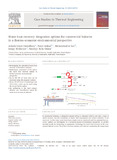JavaScript is disabled for your browser. Some features of this site may not work without it.
| dc.contributor.author | Chowdhury, Jahedul Islam | |
| dc.contributor.author | Asfand, Faisal | |
| dc.contributor.author | Ja’fari, Mohammad | |
| dc.contributor.author | Mukherjee, Sanjay | |
| dc.contributor.author | Balta-Ozkan, Nazmiye | |
| dc.date.accessioned | 2023-11-20T16:33:45Z | |
| dc.date.available | 2023-11-20T16:33:45Z | |
| dc.date.issued | 2023-11-11 | |
| dc.identifier.citation | Chowdhury JI, Asfand F, Ja’fari M, et al., (2023) Waste heat recovery integration options for commercial bakeries in a thermo-economic-environmental perspective. Case Studies in Thermal Engineering, Volume 52, December 2023, Article number 103714 | en_UK |
| dc.identifier.issn | 2214-157X | |
| dc.identifier.uri | https://doi.org/10.1016/j.csite.2023.103714 | |
| dc.identifier.uri | https://dspace.lib.cranfield.ac.uk/handle/1826/20565 | |
| dc.description.abstract | In commercial bakeries, a substantial amount of heat is exhausted which is not only a waste of useful resource, but also contributes to higher fuel consumption and carbon emissions, if not recovered. In this study, waste heat from a single oven is considered and five potential heat recovery options are investigated in a techno-economic-environmental perspective to provide essential results for integrating an appropriate technology for waste heat recovery in the commercial bakeries sector. Waste heat recovery options were selected considering the temperature profile, the waste heat source, quality and quantity of heat and the heat energy demand for the various processes in commercial bakeries. Thermodynamic, economic, and environmental models are developed to assess the heat recovery performance, cost savings and emission reduction at both design and off-design conditions. Results show that up to 286 kW of waste heat can be recovered and reused in the case of air pre-heater, which can save up to 161.93 t/year of natural gas and an equivalent cost and emission savings of $ 93,594/year and 412.5 tCO2e/year, respectively. Moreover, the earliest payback period of 0.77 years was estimated for the air pre-heater option with an estimated capital investment cost of $71,631, whereas a maximum payback period of 4.59 years was estimated for the electricity generation by the organic Rankine cycle having an estimated capital investment cost of $304,040. These results reveal that air preheating is the most energy-efficient and cost-effective option to recover the waste heat from the ovens in the bakery industry. | en_UK |
| dc.language.iso | en | en_UK |
| dc.publisher | Elsevier | en_UK |
| dc.rights | Attribution 4.0 International | * |
| dc.rights.uri | http://creativecommons.org/licenses/by/4.0/ | * |
| dc.subject | Waste heat recovery | en_UK |
| dc.subject | Organic rankine cycle | en_UK |
| dc.subject | Energy analysis | en_UK |
| dc.subject | Energy efficiency | en_UK |
| dc.subject | Economic analysis | en_UK |
| dc.title | Waste heat recovery integration options for commercial bakeries in a thermo-economic-environmental perspective | en_UK |
| dc.type | Article | en_UK |
Files in this item
The following license files are associated with this item:
This item appears in the following Collection(s)
-
Staff publications (SWEE) [2838]

